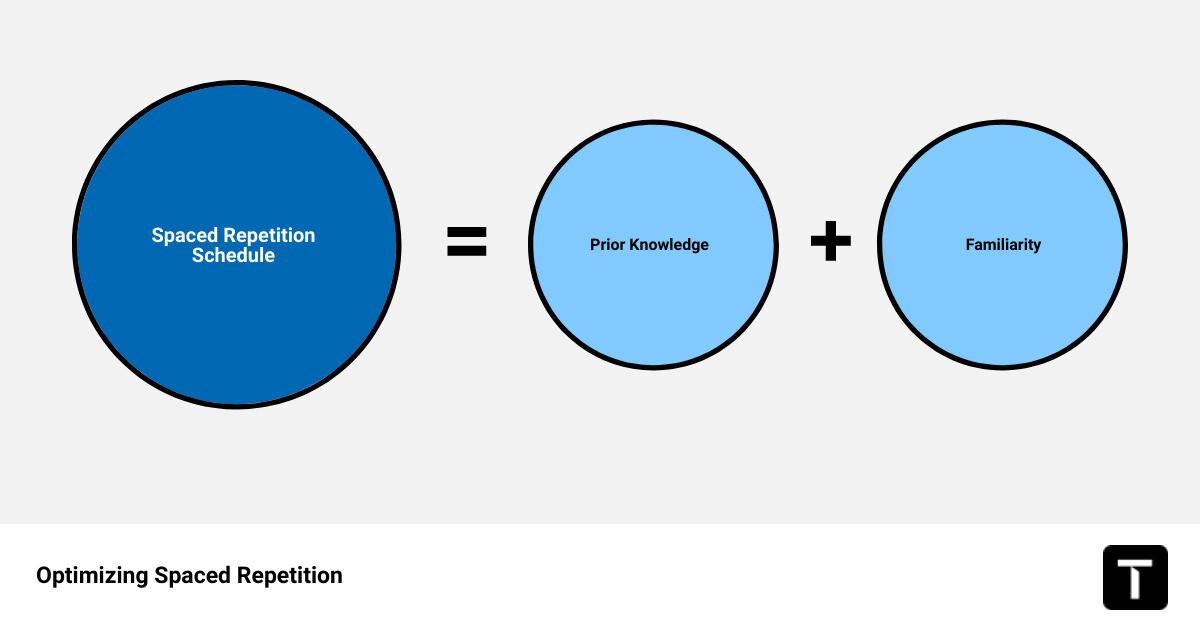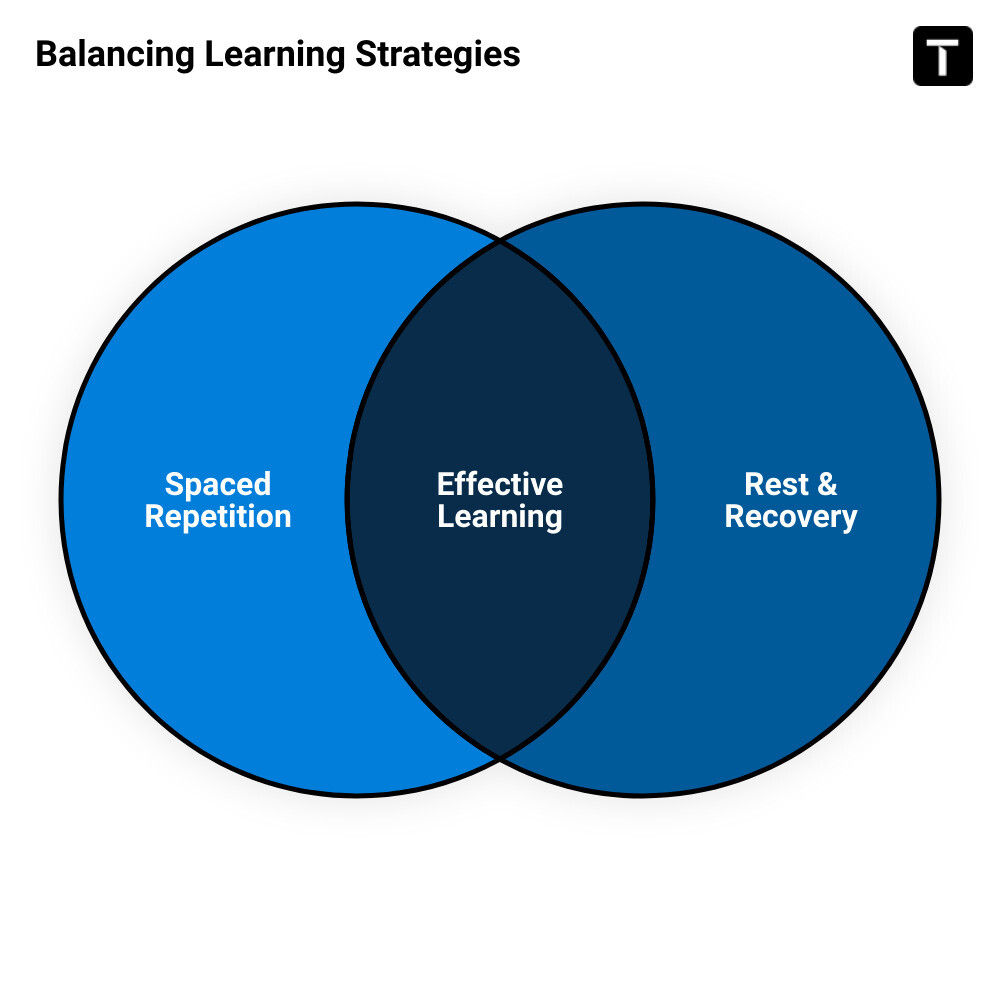Your path to success in learning Mandarin, including mastering those tricky Chinese characters, could be as simple as spacing out your study sessions. Welcome to the world of spaced repetition, a science-backed learning method that's all about timing. In this article, we'll explore how often you should do spaced repetition to optimize your learning efficiency and achieve long-term retention.
Spaced repetition is a learning strategy that involves reviewing information at increasing intervals over time. It's like a gym workout for your brain, where your mental muscles get stronger with each repetition. This technique is widely recognized for enhancing not only memory retention but also the overall learning process.
If you've ever struggled with forgetting what you've studied just a few days or weeks later, spaced repetition could be the solution you're looking for. It's not about cramming or endless repetition; it's about strategically planning your study sessions to match your brain's natural memory processes.
Stay tuned as we delve into the science behind spaced repetition, its benefits, and most importantly, how often you should incorporate it into your learning routine to unlock success. Whether you're an aspiring polyglot, a future mathematician, or simply someone who enjoys learning, understanding the principles of spaced repetition can revolutionize the way you acquire and retain new information.

Understanding the Science Behind Spaced Repetition
Just like a well-trained athlete understands the mechanics of their sport, effective learners need to understand the science behind their learning techniques. In the realm of spaced repetition, this means diving into the realm of cognitive science to explore the role of neurons and synapses in memory retention, the impact of the forgetting curve on learning, and the influence of the spacing effect on memory.
The Role of Neurons and Synapses in Memory Retention
The human brain is a wonder of nature, composed of approximately 86 billion nerve cells called neurons. These neurons are the fundamental building blocks of the brain, and their connections, known as synapses, are the highways of information transfer. When we acquire new knowledge, these neurons and their synapses become more strongly connected, forming a robust network. The more we recall information, the stronger these networks become, making it easier to remember the information in the future. This neural strengthening is a key aspect of why spaced repetition is such an effective learning strategy.
The Forgetting Curve and Its Impact on Learning
Imagine you've just learned a new set of Chinese characters. How long do you think you'll remember them without review? This is where the forgetting curve comes into play. Developed by psychologist Hermann Ebbinghaus in the late 19th century, the forgetting curve illustrates how memories decay over time without reinforcement. Initially, memory loss is rapid, but over time, the rate of forgetting slows down.
However, Ebbinghaus also discovered that this memory decay could be counteracted through timely repetitions, resetting the forgetting curve and boosting memory retention. This is the cornerstone principle behind spaced repetition.
The Spacing Effect and Its Influence on Memory
The spacing effect is another critical component of effective learning. It suggests that our brains encode information more effectively when our study sessions are spread out over time, rather than crammed into a single marathon session. Think of it like building a brick wall: If you rush and stack all the bricks at once without allowing the mortar to dry, the wall won't be sturdy. By allowing time between study sessions, your mental 'mortar' gets a chance to solidify, leading to stronger and more durable memory networks.
In a nutshell, understanding the science behind spaced repetition, from the role of neurons and synapses in memory retention to the forgetting curve and the spacing effect, can empower you to maximize your learning efficiency. By harnessing these principles, you can optimize your study sessions and unlock success in your learning journey.
The Mechanics of Spaced Repetition
Let's dive into the mechanics of spaced repetition to further unravel how this powerful learning strategy works. This involves understanding the process of spaced repetition, emphasizing the significance of active recall, and highlighting the role of testing.
The Process of Spaced Repetition
Spaced repetition is akin to a gym workout for your brain. The same way you wouldn't lift a 100-pound dumbbell on your first visit to the gym, you wouldn't attempt to cram all your Mandarin study materials in one session. Instead, you'd start with smaller "weights" or smaller chunks of information, gradually increasing the "weight" or complexity of information as your "mental muscle" develops.
The process of spaced repetition involves repeatedly reviewing your lessons at increasing intervals, ensuring that important lessons are unforgettable. The material doesn't have to be presented identically in each review session. Variations in teaching the same concepts are encouraged, as long as there are time gaps between sessions. This practice allows the production of a "spacing effect," a phenomenon where the brain is trained to store information longer in long-term memory, mirroring how muscles get stronger with regular and spaced out workouts.
The Importance of Active Recall in Spaced Repetition
Active recall, the act of stimulating memory during learning, serves as the heartbeat of spaced repetition. Unlike passive review, where information is simply presented, active recall requires the brain to work harder, leading to stronger neural pathways. It's a form of mental gymnastics that strengthens our memory muscles.
Active recall in the realm of spaced repetition isn't a one-time event. It's a continuous process, repeated at increasing intervals. This active engagement in recalling information, coupled with optimal spacing intervals, forms the backbone of spaced repetition as a potent learning strategy.
The Role of Testing in Enhancing the Effectiveness of Spaced Repetition
Testing plays a critical role in enhancing the effectiveness of spaced repetition, a principle known as the "testing effect" in cognitive science. It asserts that actively testing yourself on a piece of knowledge, instead of passively re-reading that same piece of knowledge, is more effective.
This principle is backed by a recent meta-analysis of 118 studies in cognitive science, which revealed that the testing effect is, on average, 51% more effective compared to passive re-reading, and 93% more effective compared to 'doing nothing'. By integrating active recall with testing and ideal spacing intervals, spaced repetition becomes a formidable tool in your Mandarin learning journey.

How Often Should You Do Spaced Repetition?
Unlocking the power of spaced repetition is all about timing. The question of how often should you do spaced repetition has a deeply scientific answer, but in practice, it's also about adapting to your individual needs and circumstances. In this section, we'll delve into the optimal spaced repetition intervals and share tips on how to tailor your schedule for exams and based on your familiarity with the subject matter.
The Optimal Spaced Repetition Intervals
Imagine this: You're learning Mandarin, and you're presented with a new character. When should you review that character again? According to a synthesis of various spaced repetition systems, an optimal schedule may look something like this: initial learning (Day 0), followed by repetitions on Day 1, Day 6, Day 14, Day 30, Day 66, Day 150, and Day 360. This schedule, characterized by gradually increasing intervals, is often sufficient for lifelong retention of information.
However, it's important to note that finding the "perfect" schedule for spaced repetitions can lead to very marginal gains, with studies showing only a 3% difference in effectiveness between such optimal schedules and fixed repetition schedules. The real benefit comes from the active recall testing and the spacing of study sessions itself. In other words, don't lose sleep over the precise timing - the fact that you're using spaced repetition already puts you ahead in your Mandarin learning journey!
Adapting the Spaced Repetition Schedule Based on Prior Knowledge and Familiarity
Your personal familiarity with a subject can impact the effectiveness of your study schedule. Before diving into a new Mandarin character or phrase, assess your baseline knowledge. For topics you're already familiar with, you can start with longer intervals between study sessions, since your brain will require less frequent reviews. On the contrary, allocate more time and shorter intervals to new or challenging concepts in your spaced repetition schedule. As you become more comfortable, gradually increase the intervals between study sessions.
Customizing the Spaced Repetition Schedule for Exams
When exam season approaches, your spaced repetition schedule will need some tweaks to maximize your performance. Here's how:
Prioritize high-yield material: Concentrate on the most critical topics and concepts that are likely to appear on the test, prioritizing them in your schedule.
Adjust intervals for shorter timeframes: You'll need to shorten the time between reviews to ensure you can cover all the essential material, while still maintaining the principle of gradually increasing intervals.
Incorporate practice questions: Simulate practice questions in your study sessions to reinforce your understanding and apply your knowledge in exam-like conditions.
Factor in time for rest and recovery: Include regular breaks and rest days in your study plan to avoid burnout and ensure effective retention of information.
Monitor progress and adjust as needed: Continuously assess your progress and adjust your study plan as needed. Stay flexible and responsive to your learning needs, and remember that it's okay to tweak your spaced repetition schedule as you go.
By considering these factors, you can optimize your spaced repetition schedule, enhancing your Mandarin language skills and setting yourself up for success in both your learning journey and exam performance.

Tools and Techniques for Implementing Spaced Repetition
Harness the power of science-backed techniques and the convenience of digital tools to supercharge your spaced repetition learning journey. Let's delve into the Leitner System and explore popular digital platforms like Anki, RemNote, and Traverse.
The Leitner System: A Time-Tested Approach to Spaced Repetition
The Leitner System, named after German scientist Sebastian Leitner, is an elegantly straightforward method that maximizes memory retention using flashcards. Each card contains a question or concept on one side, and the answer or explanation on the other. These cards are sorted into different boxes representing specific review intervals. Correctly recalled cards advance to a box with a longer review interval, while incorrectly recalled ones return to the first box for more frequent review. This system ensures efficient study sessions by focusing on the right information at the right time[^1^][^2^].
Digital Tools for Spaced Repetition: Anki, RemNote, and Traverse
As digital technology advances, it brings along tools like Anki and Traverse, making spaced repetition more accessible and efficient. Anki is popular for its flexibility and extensive shared decks. However, it's important to remember that Anki should not be used as the only method of studying, as over-reliance can lead to a superficial understanding of the material[^1^].
Another digital tool, RemNote, allows users to add notes with context. However, its text-first approach can make it challenging to deeply grasp complex topics[^1^].
How Traverse Enhances Spaced Repetition with Mind Mapping and Connected Note-Taking
Breaking new ground in the digital learning experience is Traverse, which offers unique features that enhance integration, context, and convenience in your learning journey[^3^]. You can import your existing Anki decks into Traverse and continue your learning there, adding a broader context to your learning[^2^][^3^].
Furthermore, Traverse allows you to create flashcards directly from your notes and view them within your knowledge tree. This integration is particularly beneficial for complex topics like Mandarin Chinese[^3^].
As you strive to master Mandarin and other subjects, take advantage of these tools and techniques to implement spaced repetition effectively. They can help optimize your learning efficiency, making your journey more enjoyable and productive.
[^1^]: Boost Your Study Skills with the Secret Technique Everyone Is Talking About | Traverse [^2^]: Unlock Your Learning Potential with Fascinating Spaced Repetition Techniques | Traverse [^3^]: Is There an optimal Spacing Formula for Spaced Repetition? Debunking Common Myths | Traverse

Balancing Spaced Repetition with Other Learning Strategies
Mastering the art of effective learning goes beyond a single technique. As you climb the towering mountain of Mandarin, balancing spaced repetition with other learning strategies will be your guide to reach the summit.
The Importance of High-Quality Study and Avoiding Burnout
In the quest for knowledge, quality trumps quantity. Spending hours on end reviewing flashcards might seem like the path to mastery, but it could lead to information overload and mental fatigue. Studies suggest that obsession over a spaced repetition schedule might not be the best use of your time. Instead, it's crucial to ensure that each study session is meaningful and productive. Remember, the goal of spaced repetition is to make your study sessions more efficient, not more extended.
Moreover, the danger of burnout is very real. Overworking can lead to diminished performance and a decline in motivation. Therefore, it's essential to pace yourself, take regular breaks, and allow your mind time to rest and consolidate the information.
The Role of Rest and Recovery in Effective Learning
Sleep and downtime play a crucial role in memory consolidation - the process of stabilizing and strengthening the memories formed during your study sessions. Your brain needs this time to process and integrate the new information into your long-term memory. So don't skimp on your sleep or relaxation time. They're not a luxury; they're a necessity for effective learning!
The Need to Understand and Encode Information Properly for Effective Spaced Repetition
Getting the most out of your spaced repetition routine also hinges on how well the information is encoded in your long-term memory. Like a computer that can't retrieve a file that hasn't been correctly saved, your brain can't recall information that hasn't been well understood or encoded.
Avoid rote memorization and aim for a deep understanding of the material. Engage actively with the content, connect new information to what you already know, and use mnemonic strategies where appropriate. The better the understanding, the fewer the repetitions needed to master the material. In fact, these so-called 'encoding techniques' are used by only 12% of students, despite their high potential for increasing retention.
In conclusion, successful learning isn't solely about using spaced repetition. It's about a balanced blend of effective strategies - a deep understanding of the material, quality over quantity in study sessions, adequate rest, and recovery, and of course, a consistent, personalized spaced repetition schedule. By mastering this delicate balance, you are well on your way to unlocking success in your learning journey.
Conclusion: Unlocking Success with Spaced Repetition
Embracing the power of spaced repetition is like discovering a secret key to the treasure chest of long-term memory. As we've seen, it's not just about repeating information, but about doing so at the optimal time intervals, engaging in active recall, and adapting your schedule based on your unique learning needs and goals. When it comes to learning Mandarin or any other complex subject, this technique can be a game-changer.
Remember, the optimal spaced repetition intervals vary depending on your familiarity with the material and your retention goals. However, a general schedule that works well in most cases involves repetitions on day 1, day 6, day 14, day 30, day 66, day 150, and day 360. This, of course, can be tweaked as per your learning needs and the demands of your exams or tests.
Don't forget, the magic of spaced repetition lies in its ability to reset the forgetting curve, making each repetition increase the time you remember the information. It's like giving your brain a workout, where each session strengthens your memory muscles, allowing you to retain information for longer periods.
Moreover, customizing your spaced repetition schedule for exams can reduce anxiety and maximize performance. Prioritizing high-yield material and adapting your schedule to ensure you're recalling information just as it's on the verge of being forgotten can make your study sessions incredibly efficient.
As for tools to help you implement spaced repetition, platforms like Traverse offer a comprehensive solution, integrating mind-mapping, connected note-taking, and of course, spaced repetition into a seamless learning experience.
Finally, remember to balance your spaced repetition with other learning strategies. A deep understanding of the material, quality study sessions, adequate rest, and recovery are all vital components of a successful learning journey.
In conclusion, unlocking success with spaced repetition is not just about the frequency of repetition, but also the timing, the method of recall, and the balance with other learning strategies. As you incorporate spaced repetition into your study routine, you're not just learning to remember; you're training your brain for success. Here's to your learning journey powered by spaced repetition - may it be filled with unforgettable knowledge!

